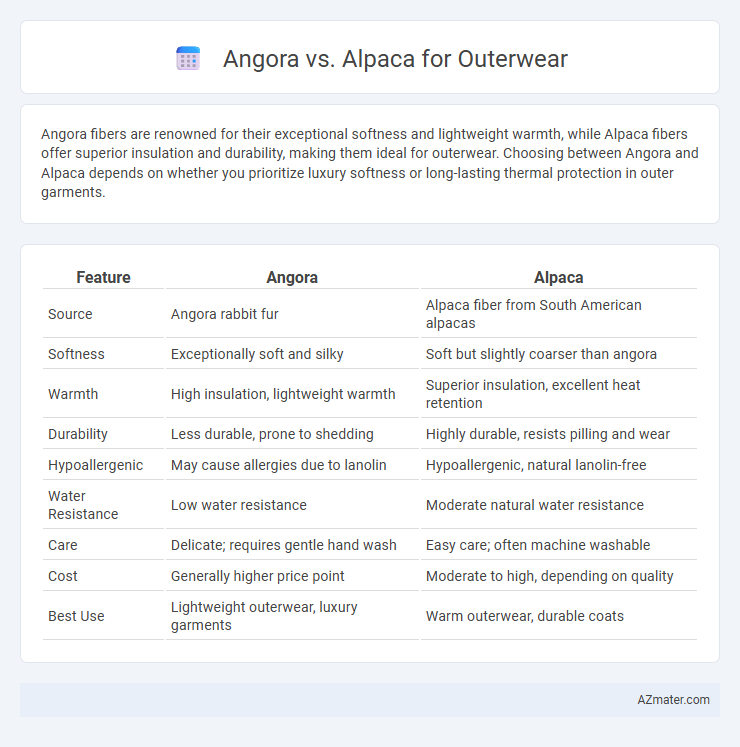Angora fibers are renowned for their exceptional softness and lightweight warmth, while Alpaca fibers offer superior insulation and durability, making them ideal for outerwear. Choosing between Angora and Alpaca depends on whether you prioritize luxury softness or long-lasting thermal protection in outer garments.
Table of Comparison
| Feature | Angora | Alpaca |
|---|---|---|
| Source | Angora rabbit fur | Alpaca fiber from South American alpacas |
| Softness | Exceptionally soft and silky | Soft but slightly coarser than angora |
| Warmth | High insulation, lightweight warmth | Superior insulation, excellent heat retention |
| Durability | Less durable, prone to shedding | Highly durable, resists pilling and wear |
| Hypoallergenic | May cause allergies due to lanolin | Hypoallergenic, natural lanolin-free |
| Water Resistance | Low water resistance | Moderate natural water resistance |
| Care | Delicate; requires gentle hand wash | Easy care; often machine washable |
| Cost | Generally higher price point | Moderate to high, depending on quality |
| Best Use | Lightweight outerwear, luxury garments | Warm outerwear, durable coats |
Introduction to Angora and Alpaca Fibers
Angora fiber, harvested from Angora rabbits, is prized for its exceptional softness, lightweight warmth, and luxurious halo effect, often used in high-end outerwear for its insulating properties. Alpaca fiber comes from the South American alpaca, known for its durability, moisture-wicking ability, and natural hypoallergenic qualities, making it ideal for cozy, breathable outerwear. Both fibers offer unique textures and thermal benefits, with Angora emphasizing softness and Alpaca offering resilience and warmth.
Key Differences in Fiber Origin
Angora fibers are derived from the Angora rabbit, renowned for their exceptional softness and silky texture, while Alpaca fibers come from the Alpaca, a South American camelid known for its warmth and durability. Angora fiber is characterized by its lightweight and high insulation properties, supporting superior thermal regulation, whereas Alpaca fiber tends to be coarser with excellent moisture-wicking capabilities, making it ideal for heavy-duty outerwear. The distinct animal origins also influence fiber length and strength, with Angora providing a finer, more delicate fabric, and Alpaca delivering resilience suitable for rugged outdoor conditions.
Texture and Softness Comparison
Angora outerwear boasts an exceptionally soft and silky texture derived from the long, fine fibers of Angora rabbits, offering a lightweight warmth with a luxurious feel against the skin. Alpaca fiber, sourced from South American alpacas, provides a slightly coarser but highly durable texture that is still remarkably soft and hypoallergenic, with excellent insulating properties. When comparing softness, Angora typically feels more delicate and smooth, while Alpaca balances softness with resilience, making both ideal for premium outerwear depending on desired warmth and tactile experience.
Warmth and Insulation Qualities
Angora fiber, derived from Angora rabbits, offers exceptional softness and warmth due to its fine, hollow structure that traps heat effectively, making it ideal for insulating outerwear. Alpaca wool, sourced from South American alpacas, provides superior thermal insulation with moisture-wicking properties, ensuring warmth without heavy weight or bulk. Both fibers outperform traditional wool in heat retention, but alpaca excels in durability and moisture management, while Angora delivers unparalleled softness and lightweight warmth.
Durability and Longevity
Alpaca fibers are renowned for their exceptional durability and resistance to pilling, making alpaca outerwear a long-lasting investment. Angora, derived from rabbit hair, offers superior softness but tends to be more delicate and prone to shedding, which can reduce the garment's lifespan. For outerwear that balances warmth with lasting wear, alpaca provides greater longevity without compromising on comfort.
Moisture-Wicking and Breathability
Alpaca fibers outperform Angora in moisture-wicking and breathability, making alpaca outerwear ideal for regulating body temperature and maintaining dryness during various activities. Angora, derived from Angora rabbits, offers softness but tends to retain moisture and lacks the same breathable quality found in alpaca fibers. Outerwear made from alpaca wool provides superior ventilation and moisture management, enhancing comfort in both cold and moderate climates.
Ethical Sourcing and Sustainability
Angora and alpaca fibers differ significantly in ethical sourcing and sustainability, with alpaca wool generally considered more eco-friendly due to the animal's gentle grazing habits and lower environmental impact. Angora production raises ethical concerns because of the intensive fur harvesting process, which can cause animal distress if not managed responsibly. Alpaca farming supports sustainable land use and promotes animal welfare, making it a preferred choice for conscientious consumers seeking sustainable outerwear options.
Care and Maintenance Requirements
Angora fiber, sourced from Angora rabbits, requires gentle hand washing or dry cleaning to prevent felting and preserve its softness, making maintenance more delicate compared to Alpaca. Alpaca wool, known for its durability and natural resistance to odors and moisture, can often be machine washed on a gentle cycle with cold water, simplifying care for outerwear garments. Both fibers benefit from proper storage away from moths and regular airing to maintain their longevity and luxurious texture.
Style and Fashion Versatility
Angora offers a luxurious, soft texture and a glossy sheen, making it ideal for high-fashion outerwear with a sophisticated, elegant appeal. Alpaca fibers provide exceptional warmth and durability while maintaining a lightweight feel, allowing for versatile, casual to formal outerwear styles. Both materials enhance garment drape and comfort, but Angora is favored for refined, statement pieces, whereas Alpaca excels in versatile, everyday fashion.
Which Fiber Is Best for Outerwear?
Angora fiber, sourced from Angora rabbits, offers exceptional softness and a silky texture ideal for luxurious outerwear, but its delicate nature requires gentle care and lower durability in harsh weather. Alpaca fiber, harvested from alpacas, is highly durable, water-resistant, and provides superior insulation, making it an excellent choice for warm, long-lasting outerwear suitable for cold climates. For outerwear that balances warmth, durability, and easy maintenance, alpaca fiber generally outperforms Angora in practical use, while Angora excels in softness and luxury.

Infographic: Angora vs Alpaca for Outerwear
 azmater.com
azmater.com